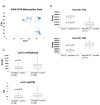A Children's Oncology Group and TARGET initiative exploring the genetic landscape of Wilms tumor
- PMID: 28825729
- PMCID: PMC5712232
- DOI: 10.1038/ng.3940
A Children's Oncology Group and TARGET initiative exploring the genetic landscape of Wilms tumor
Abstract
We performed genome-wide sequencing and analyzed mRNA and miRNA expression, DNA copy number, and DNA methylation in 117 Wilms tumors, followed by targeted sequencing of 651 Wilms tumors. In addition to genes previously implicated in Wilms tumors (WT1, CTNNB1, AMER1, DROSHA, DGCR8, XPO5, DICER1, SIX1, SIX2, MLLT1, MYCN, and TP53), we identified mutations in genes not previously recognized as recurrently involved in Wilms tumors, the most frequent being BCOR, BCORL1, NONO, MAX, COL6A3, ASXL1, MAP3K4, and ARID1A. DNA copy number changes resulted in recurrent 1q gain, MYCN amplification, LIN28B gain, and MIRLET7A loss. Unexpected germline variants involved PALB2 and CHEK2. Integrated analyses support two major classes of genetic changes that preserve the progenitor state and/or interrupt normal development.
Figures


Comment in
-
Kidney cancer: Targeting Wilms tumour.Nat Rev Nephrol. 2017 Nov;13(11):662. doi: 10.1038/nrneph.2017.131. Epub 2017 Sep 11. Nat Rev Nephrol. 2017. PMID: 28890538 No abstract available.
-
Paediatrics: Integrating genomics to dig deeper into Wilms tumour biology.Nat Rev Urol. 2017 Dec;14(12):703-704. doi: 10.1038/nrurol.2017.178. Epub 2017 Oct 25. Nat Rev Urol. 2017. PMID: 29068437 No abstract available.
References
-
- Wegert J, et al. Mutations in the SIX1/2 pathway and the DROSHA/DGCR8 miRNA microprocessor complex underlie high-risk blastemal type WTs. Cancer Cell. 2015;27:298–311. - PubMed
-
- Beckwith JB, Palmer NF. Histopathology and prognosis of Wilms tumors: results from the First National Wilms Tumor Study. Cancer. 1978;41:1937–48. - PubMed
MeSH terms
Substances
Grants and funding
LinkOut - more resources
Full Text Sources
Other Literature Sources
Medical
Research Materials
Miscellaneous

